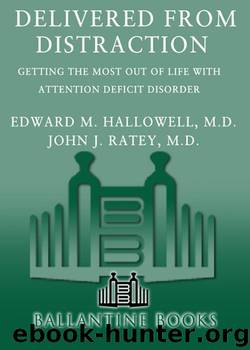Delivered from Distraction by Edward M. Hallowell M.D

Author:Edward M. Hallowell, M.D.
Language: eng
Format: mobi, epub
Tags: Nonfiction
ISBN: 9780345490988
Publisher: Random House Publishing Group
Published: 2005-12-26T21:00:00+00:00
PART FOUR
♦
Mastering the Power and Avoiding the Pitfalls: The Treatment of ADD
CHAPTER 20
THE TREATMENT OF ADD: WHAT WORKS BEST
Whether for children or adults, the treatment of ADD should be comprehensive and include a wide range of possible interventions, certainly more than medication or some other single step. Assistance should also be provided over the long-term, as ADD generally does not go away. The person being treated may not need to go see the doctor very often, but he should always know that help is just one telephone call away.
I divide a comprehensive plan into the following eight steps. Each step need not be implemented, but each step should be considered. The program was outlined in chapter 1, “The Skinny on ADD,” so I will offer only a few additional words here. Subsequent chapters will expand upon specific points that our patients have found particularly helpful.
1. Diagnosis, which should include identification of talents and strengths
2. Implementation of a five-step plan that promotes talents and strengths (detailed in chapter 22)
3. Education
4. Changes in lifestyle
5. Structure
6. Counseling of some kind, such as coaching, psychotherapy, career counseling, couples therapy, family therapy
7. Various other therapies that can augment the effectiveness of medication or replace the use of medication altogether, such as an exercise program that stimulates the cerebellum, targeted tutoring, general physical exercise, nutritional interventions, and occupational therapy
8. Medication (only if desired)
Step 1—Diagnosis, which should include identification of talents and strengths. Making the diagnosis opens the door to treatment. You should make sure your diagnosis is both accurate and complete, taking into account the likelihood of coexisting problems. Your diagnosis should delineate potential strengths and talents, because you will build your confidence and self-esteem on these.
Diagnosis is also therapeutic in itself. When you diagnose ADD, you break all those moral diagnoses that had plagued you for years.
Step 2—Implementation of a five-step plan that promotes talents and strengths. See chapter 22 for a description of this method.
Step 3—Education. The way you make the diagnosis therapeutic is by learning about your own mind and about ADD. You need to learn what ADD is and what it isn’t. You need to teach other members of your family about it. You need to explain it to teachers and to all others who deal with your child, or whomever has the ADD. Family therapy sessions can help with this. So can couples therapy.
There are various organizations that put out educational materials that can be quite helpful in bringing the truth about ADD to a wide number of people. There is a listing of educational resources at the end of this book.
Step 4—Changes in Lifestyle. There are five major elements here:
1. Sleep. Most people who have ADD do not get enough sleep. They stay up too late on their computers or watching TV, and then they have enormous trouble getting out of bed in the morning. In fact, various sleep disorders, such as delayed sleep latency or sleep apnea, may be associated with ADD. You should consult a sleep specialist if
Download
Delivered from Distraction by Edward M. Hallowell M.D.epub
This site does not store any files on its server. We only index and link to content provided by other sites. Please contact the content providers to delete copyright contents if any and email us, we'll remove relevant links or contents immediately.
| Disabilities | Hyperactivity |
What I Need by J. Daniels(1970)
The Gender Creative Child by Diane Ehrensaft & Norman Spack(1703)
Your Soul's Plan by Robert Schwartz(1609)
Aspergirls by Rudy Simone(1585)
Be Different by John Elder Robison(1558)
My Child's Different by Elaine Halligan(1428)
101 Tips for the Parents of Boys with Autism by Ken Siri(1382)
Asperger Syndrome (Autism Spectrum Disorder) and Long-Term Relationships by Ashley Stanford(1331)
Meditation: Meditation For Beginners - How to Meditate For Lifelong Peace, Focus and Happiness (Mindfulness, Meditation Techniques) by Price Sara Elliott(1322)
The Sensory Child Gets Organized by Carolyn Dalgliesh(1321)
ADHD by Mark Selikowitz(1304)
Nerdy, Shy, and Socially Inappropriate by Cynthia Kim(1272)
An Adult with an Autism Diagnosis by Gillan Drew(1265)
Animal-assisted Interventions for Individuals with Autism by Temple Grandin(1223)
Baby Signing for Dummies by Jennifer Watson(1216)
Somebody Else's Kids by Torey Hayden(1201)
Seeing Ezra by Kerry Cohen(1199)
The Yoga Bible by Christina Brown(1197)
Overcoming ADHD by Stanley I. Greenspan & Jacob (con) Greenspan(1167)
